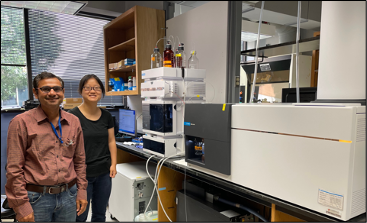
Overview
The Metabolic Phenotyping Core centralizes existing metabolism-related resources, services, and training at OMRF to support the junior investigators in this Cellular Metabolism Research program.
The Core provides support to our current Project Leaders in three areas:
- Measurement of cellular respiration and mitochondrial function
- Isotopic metabolite tracer analyses
- Mass spectrometry metabolic profiling and bioinformatic analyses

Overall, the Core enables our COBRE investigators to conduct comprehensive functional analyses of cellular metabolism to keep them on the leading edge of their respective fields. In the long run, the Core will help expand metabolism research capabilities throughout Oklahoma.
Staff and Expertise
Dr. Kenneth Humphries serves as the Director of the COBRE Metabolic Phenotyping Core and is an Associate Professor in the Aging & Metabolism Research Program and. He provides administrative and scientific oversight of the Core. Dr. Humphries has long-standing interests and expertise in mitochondrial and free radical biology. He has analyzed mitochondrial function and ROS production in numerous tissue types and experimental models and has collaborated with multiple labs at OMRF and OUHSC over the past decade. He advises junior investigators of this COBRE in the proper design, implementation, and interpretation of metabolism experiments.
Dr. Timothy Griffin is an Associate Professor in the Aging & Metabolism Research Program. Dr. Griffin has over 20 years of relevant experience and special expertise in comparative metabolic physiology, obese mouse pathophysiology, and immunometabolism osteoarthritis research. He led the development of mouse metabolic phenotyping services at OMRF.
Dr. Benjamin Miller is Professor and Chair of the Aging & Metabolism Research Program at OMRF. He serves in leadership positions of various cores and centers. He has used stable isotopes to study metabolic turnover and flux and developed an independent training program of isotope research. Through collaboration with his peers, he has built connections with experts in isotope studies in the United States as well as in Europe.
Dr. Atul Pranay is an Associate Staff Scientist with multidisciplinary and diverse expertise in mass spectrometry (LC-MS/MS & GC/MS), targeted metabolic studies, and stable isotope metabolic flux analysis. He oversees the metabolic profiling studies using the Core’s LC/MS & GC/MS instruments and serves as the project coordinator. Dr. Pranay came to OMRF with experience in both industry and postdoctoral research carried out at the University of Tennessee Health Science Center. Dr. Pranay has extensive experience in analytical method development, sample preparation, experiment planning, biomarkers and bioavailability, and data analysis for metabolomics and tracer analysis studies. Dr. Pranay can assist investigators with many types of experimental questions whether their interest is metabolite analysis in cultured cells (media and homogenates), tissue homogenates (heart, skeletal muscle, brain, liver, etc.), or blood/sera.
Dr. Satoshi Matsuzaki is an Associate Staff Scientist with 76 years of research experience in mitochondrial biochemistry and molecular biology. He is an expert in mitochondrial enzymology and Seahorse XF metabolic analysis. He provides service and training for cell respiration and mitochondria functional analyses.
Dr. Jie Zhu is an Assistant Staff Scientist. She has developed expertise in conducting radiolabeled metabolic substrate flux analyses. She has finished the Agilent 1290 Infinity II-6546 UHPLC-qTOF instrument training courses and assists in sample preparation and analysis of stable-isotopic 13C-MFA LC-MS/MS experiments with Dr Pranay.
Equipment
All equipment in this core is centralized in the Aging & Metabolism Research Program and includes:
- Agilent Seahorse XFe24 and XFe96 Extracellular Flux Analyzers;
- Oroboros O2k high-resolution respirometry;
- Agilent 1290 Infinity II-6546 UHPLC-qTOF;
- Agilent 5977A GC-MS system;
- Agilent 7010B Triple Quadrupole GC/MS system;
- BioSpherix hypoxia system;
- Los Gatos Research LWIA-912 enhanced performance liquid water isotope analyzer;
- Tier 2 Gray Data Center (TIA-942 standard) with private “cloud” cluster support for 11TB RAM, >1200 CPU cores, and 29TB local scratch storage for bioinformatic computation.





